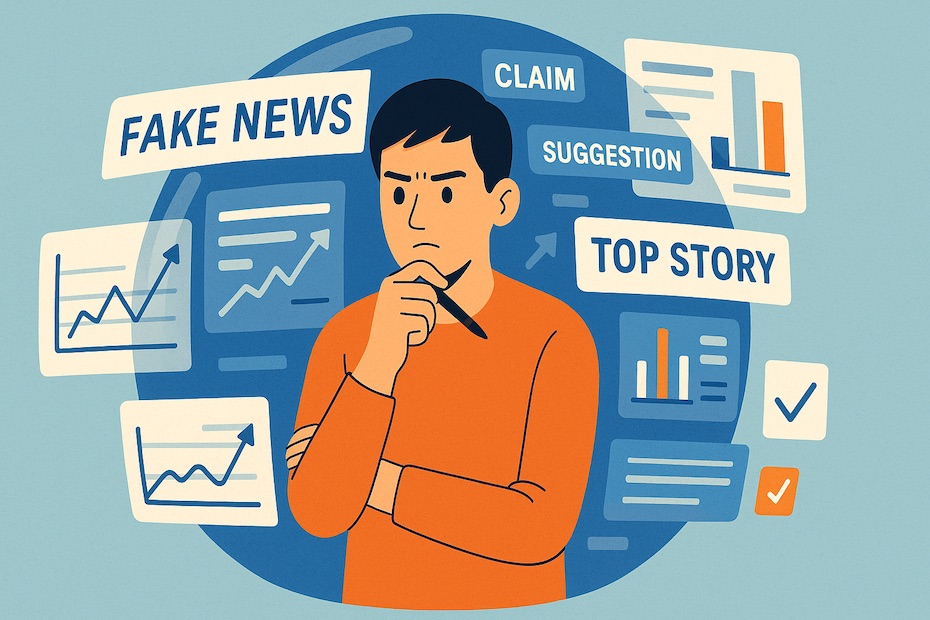So, You Think You’re a Human Lie Detector?
Ah yes, the internet: where everyone has a PhD, your uncle is suddenly an epidemiologist, and “a guy on TikTok” is now your primary source of news. You, however, are different. You’re confident. You can smell misinformation from a mile away. You know real facts when you see them. Right?
Well… welcome to the chaos of research methodology. It’s like adulting but with fewer life skills and more footnotes. You’ve bravely decided to sift through mountains of “experts,” contradicting headlines, and AI-generated nonsense to find The Truth™—and no, shouting “source?” in the comments section doesn’t count.
So buckle up, detective. It’s time to learn how to spot real information without getting emotionally catfished by a meme.
The Illusion of Being Well-Informed (a.k.a. “I Read the Headline” Syndrome)
You stumble across an article with just enough graphs to look legit and a headline like, “Broccoli Will Kill You by 2027.” You share it instantly. Why wouldn’t you? There’s a stock photo of a scientist wearing goggles!
But then you realize the site’s called infoharvest.biz.ru and was last updated in 2014. Oops.
Here’s where the reality hits: reading headlines isn’t reading, and websites with names like “truthrevealz” aren’t bastions of intellectual integrity. Sorry.
The Wikipedia Wormhole (a.k.a. “Just One More Link”)
You bravely enter Wikipedia. It’s a noble start. But before you know it, you’ve clicked your way from “confirmation bias” to “history of spoon design in medieval Prussia.” Fascinating? Sure. Relevant? Absolutely not.
You start noticing little [citation needed] tags everywhere—like tiny warning signs that say, “Proceed with skepticism, buddy.”
Eventually, you realize that while Wikipedia is a decent springboard, you probably shouldn’t cite it like it’s the Constitution.
The Social Media Mirage (a.k.a. “But It Had 3 Million Views!”)
Now you’re deep in the jungle of Instagram infographics and TikTok professors. That one guy with the ring light and serious eyebrow gestures seems convincing, until you find out his only credential is “Internet Personality.”
You start wondering: who ARE these people? Where did they get their stats? Why is everything “breaking news”?
Congratulations, you’ve reached the moment where you realize popularity ≠ credibility. Just because it went viral doesn’t mean it’s verified. (Looking at you, flat-Earth TikTok.)
The SIFT Awakening (a.k.a. “Wait, I Can Fact-Check Stuff?”)
You’ve now entered the golden age of intentional skepticism. Someone tells you a shrimp ran for mayor in a small town (which did happen, thank you, Google), and instead of immediately believing them, you check another source. You read laterally. You “Stop. Investigate. Find better coverage. Trace the claim.”
You feel powerful. You feel like Sherlock Holmes, if Sherlock Holmes had Wi-Fi and hated clickbait.
The CRAAP Moment (Yes, That’s a Real Acronym)
You now assess information using the CRAAP test:
Currency, Relevance, Authority, Accuracy, Purpose.
It sounds silly, but it’s your new nonsense filter. If a source fails two or more categories, into the digital trash it goes—right next to your ex’s mixtape and that “detox tea” ad.
You start spotting bias faster than a Real Housewife at a reunion. You check who funds a study. You look up the journal name. You even read the fine print. Who are you?
The Academic Dive (a.k.a. “Why Is This Paper in Ancient Greek?”)
You decide to level up and read peer-reviewed studies. Big mistake. It’s like trying to decode alien hieroglyphics written by caffeinated robots. You squint through pages of methods and confidence intervals and wonder if “p-value” is short for “please help.”
Eventually, you realize you don’t need to understand everything, just enough to know if it’s legit. Was it published in a respected journal? Were the authors experts? Did someone replicate it—or was it a one-time “statistical miracle”?
You push through. You endure the jargon. You survive.
You’ve Become “That Friend” (a.k.a. “Well Actually…” Syndrome)
You’ve reached peak research ninja. Friends send you links and you immediately respond with, “That site’s owned by a beverage lobbyist.” You fact-check memes for fun. You question everything.
Your group chats are scared of you. But secretly impressed.
Sure, you might be slightly insufferable at dinner parties, but you’ve evolved. You’re no longer swayed by flashy charts or catchy headlines. You are the lighthouse in a stormy sea of misinformation.
How to Evaluate Sources and Dodge Misinformation
- Check the author’s credentials and publication source
- Look for current, peer-reviewed, and cited data
- Avoid websites with flashy claims and zero references
- Use CRAAP and SIFT to verify facts
- Cross-check with reputable outlets and academic databases
Conclusion: Congrats, You’re Officially Annoying (In a Good Way)
Let’s be real—your ability to evaluate sources now outshines most people’s ability to make toast without burning it. You’ve battled sketchy websites, slayed pseudo-experts, and emerged wiser, more skeptical, and just paranoid enough to avoid being duped by another “study” sponsored by the Coalition for Magical Thinking.
Keep questioning. Keep verifying. And always remember: if it sounds too ridiculous to be true… it’s probably on Facebook.
Final Pro Tip: Misinformation doesn’t sleep, and neither should your curiosity.
Want more hot takes backed by cool facts? Head over to Medium where we keep the research real and the nonsense ratio low.

Cassandra Toroian is the founder of Firsthand Research and an entrepreneur-investor with 25+ years in the finance/RIA industry. A former sell-side/buy-side analyst, investment banker, and portfolio manager, she now focuses on fintech/DeFi and data-driven products. She’s the author of Don’t Buy the Bull and host of the podcast of the same name.

